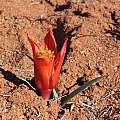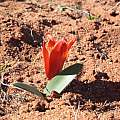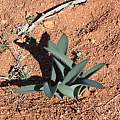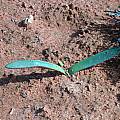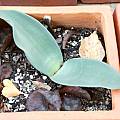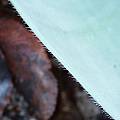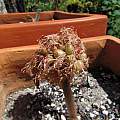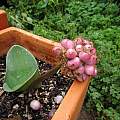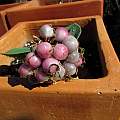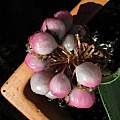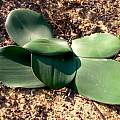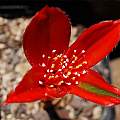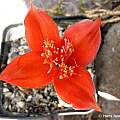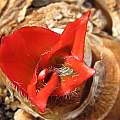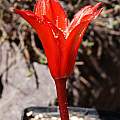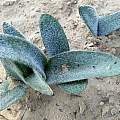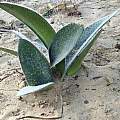Haemanthus pubescens L.f. is found on the sandy coastal plain from southern Namibia to Cape Town. In habitat it flowers March to April, occasionally earlier and is in leaf from March to October. It has 4 to 5 large fleshy spathe valves which surround the bright red or sometimes pink flowers. There are three subspecies.
Haemanthus pubescens ssp. arenicola Snijman is distinguished from the others by being softly pubescent on the undersides (abaxial) of the leaves, or sometimes glabrous. The leaves are channeled and recurved. This subspecies was published as ssp. arenicolus, but is now accepted as ssp. arenicola. The small populations of several individuals each are found in the coastal plains of southern Namibia and Namaqualand on wind-blown sandy soil. It usually blooms a bit earlier than some of the other subspecies. Bulbs are laterally compressed and form clumps. Since the basal disc persists the bulbs are usually elongated and often have an extended root zone. Photos taken by Alan Horstmann in habitat.
Photos 1-2 were taken by Uluwehi Knecht, where photo 2 shows light hairs on the leaf margin. Photos 3-6 were taken by Nhu Nguyen. These photos show an immature infructescence and mature fruits which resulted from self-pollination. Unfortunately, this bulb had a mosaic virus and the virus were passed down to the seedlings. The seedlings showed mottled young leaves and none of them return the following year after their first summer dormancy. There is a chance that virus particles were passed on from the maternal fruit tissue, but attempts to bleach the seeds also failed.
Haemanthus pubescens ssp. leipoldtii Snijman is distinguished from the others by having no hairs on either the upper or undersides of the leaves. If hairs are present, they are only found on the leaf margins. Leaves are prostrate and planar. Bulbs are mostly solitary and are laterally compressed. It is known only from a small area of Namaqualand north of the Olifants river where windblown sand accumulates. Flowers have spathe valves that are the largest in the genus. The first photo from Alan Horstmann. The second photo from iNaturalist taken by Alex Lansdowne and shared under a CC BY-NC license.
Haemanthus pubescens ssp. pubescens is distinguished from the others by being densely pubescent on the upper (adaxial) side of the leaves. It occurs in loose sandy soil of the strandveld and coastal fynbos of the Western Cape. Bulblets form much more readily than the other two subspecies. The first four photos from Hans Joschko. The last two photo from iNaturalist taken by Wian du Plessis and shared under a CC BY-NC license.
